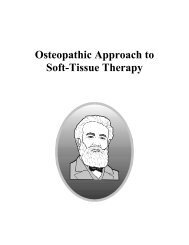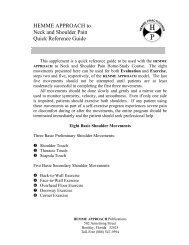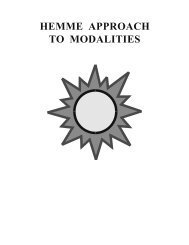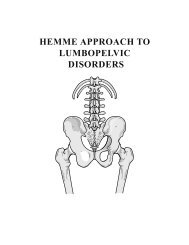HEMME APPROACH TO SOFT-TISSUE THERAPY
HEMME APPROACH TO SOFT-TISSUE THERAPY
HEMME APPROACH TO SOFT-TISSUE THERAPY
You also want an ePaper? Increase the reach of your titles
YUMPU automatically turns print PDFs into web optimized ePapers that Google loves.
Lines and arrows show which directions of movement are possible within<br />
the model. Therapy begins when the patient enters the system. Step one is<br />
titled ENTER PATIENT. The first two basic steps in the model, titled HIS<strong>TO</strong>RY<br />
and EVALUATION, define the patient's problem. History refers to medical<br />
history and evaluation refers to physical evaluation.<br />
The next step in the model is ALTERNATIVES. This step is a link between<br />
the problem as defined by HIS<strong>TO</strong>RY and EVALUATION and possible solutions<br />
as defined by MODALITIES, MANIPULATION, and EXERCISE.<br />
Alternatives should be specifically defined. If modalities, manipulation, or<br />
exercise are needed, practitioners should know specifically which modalities,<br />
manipulations, and exercises are needed. Workable plans for therapy should<br />
include goals, timetables, and measurable results. If therapy involves more<br />
than one practitioner, responsibilities are assigned.<br />
The steps MODALITIES, MANIPULATION, and EXERCISE are situated on one<br />
line to emphasize that therapy can include one or more of these three steps.<br />
MANIPULATION was given a central position because soft-tissue therapy<br />
focuses on manipulation, with modalities and exercise secondary.<br />
The next step is FEEDBACK. Like homeostatic mechanisms that regulate<br />
blood pressure, the <strong>HEMME</strong> <strong>APPROACH</strong> uses positive and negative feedback to<br />
regulate the course of therapy. Positive feedback validates the course of<br />
therapy being followed and negative feedback indicates a need for change.<br />
Changes can be made in several ways: (1) repeat steps (2) change the sequence<br />
for using steps, (3) seek new information and reenter the system, or (4) exit the<br />
system.<br />
The step for entering new information, upper left-hand corner of the<br />
<strong>HEMME</strong>GON, is titled OUTSIDE INFORMATION. Like any living system, the<br />
<strong>HEMME</strong> <strong>APPROACH</strong> is capable of receiving and processing input from the<br />
outside. This step can be used to enter outside information from sources such<br />
as consultation, research, or laboratory testing. After receiving and processing<br />
the new information, the practitioner can enter the model at four points: (1)<br />
HIS<strong>TO</strong>RY, (2) EVALUATION, (3) ALTERNATIVES, or (4) FEEDBACK.<br />
Practitioners can exit the system by using FEEDBACK to reach the steps<br />
titled OBJECTIVES SATISFIED or OBJECTIVES NOT SATISFIED. If the objectives of<br />
therapy are not satisfied, the patient may exit the system or reenter at any of<br />
the five basic steps. HIS<strong>TO</strong>RY and EVALUATION can be reentered directly,<br />
16<br />
<strong>HEMME</strong> Approach to Soft-Tissue Therapy









